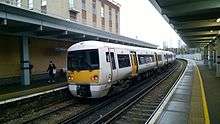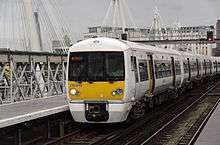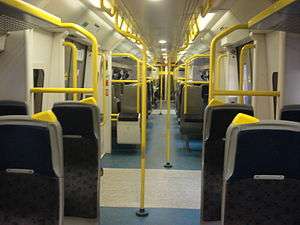British Rail Class 376
| British Rail Class 376 "Electrostar" | |
|---|---|
|
376033 approaches Hither Green | |
|
The interior of a Class 376 | |
| In service | 16 August 2004 - Current |
| Manufacturer | Bombardier Transportation |
| Family name | Electrostar |
| Replaced | |
| Constructed | 2004-2005[1] |
| Number built | 36 units |
| Formation |
5 cars per unit DMSO-MSO-TSO-MSO-DMSO[1] |
| Capacity | 344 seats[1] |
| Operator(s) | Southeastern |
| Specifications | |
| Maximum speed | 75 mph (121 km/h)[1] |
| Electric system(s) | 750 V DC third rail |
| Current collection method | Contact shoe |
| Coupling system | Dellner[1] |
| Track gauge | 1,435 mm (4 ft 8 1⁄2 in) standard gauge |
The Class 376 Suburban Electrostar is a model of electric multiple-unit passenger train manufactured by Bombardier Transportation at their Derby works. It is part of the Electrostar family, which are the most common EMUs introduced since the privatisation of British Rail. The units were ordered by Connex South Eastern, introduced in 2004/2005 by South Eastern Trains originally to replace Class 465 and Class 466 to be transferred to the Outer Suburban services to Kent.
Design


It is a derivative of the Class 375 Electrostar designed specifically for use on the high-volume metro routes running from Central London, and through Southeast London in the UK. The changes are mostly focused on increasing the trains’ capacity and decreasing station dwell times. The Class 376’s doors are wider to allow more passengers to board at once, and are metro-style sliding pocket doors which are faster and more reliable than the Class 375’s plug doors, although they do not close flush with the bodyside and hence are less aerodynamic and do not provide as much thermal insulation. The units have 2 sets of double doors per side in each carriage. Also, no air conditioning is provided, with hopper style windows available for ventilation. In order to provide more standing room, the trains also have fewer seats, more handrails, and no on-board toilets (South Eastern promised to provide additional facilities in their stations to compensate) and are limited to in-service journeys of 57 minutes as a result.
Class 376 units have five carriages, and unlike the Class 375, have full-width cabs instead of gangways at the ends of the train; it is therefore not possible to walk between two coupled Class 376 units. The cab front is also smooth and ‘step free’ to reduce the problem of ‘train surfing’ in South London.
Like all new trains in the United Kingdom using third-rail power, one carriage in each unit has a recess in its roof where a pantograph could be fitted, so as to allow for future conversion to overhead AC power.
Although all units are DC only, the class is numbered in the 3xx series normally used for AC and dual-voltage units. There is a need to change the configuration of these units as per the implementation of Network Rail's Kent Route Utilisation Strategy. The Class 376 units would be anomalous within a network being reconfigured to 12-coach running.
Routes
The Class 376s operate on the high-density routes in South East London and Kent with their main roles being London to Dartford and London - Hayes (Kent).
Maintenance
All Class 376 trains were allocated to Slade Green depot, but due to the high volume of work there, these trains are sent to Ramsgate for routine maintenance.
Fleet details
| Class | Operator | No. Built | Year Built | Cars per Unit | Unit nos. |
|---|---|---|---|---|---|
| Class 376 | Southeastern | 36 | 2004-05 | 5 | 376001 - 376036 |
See also
- Classes 357, 375, 377, 378 & 379 Electrostar
- Classes 168, 170, 171 & 172 Turbostars
- Southeastern
- Bombardier
References
External links
| Wikimedia Commons has media related to British Rail Class 376. |
